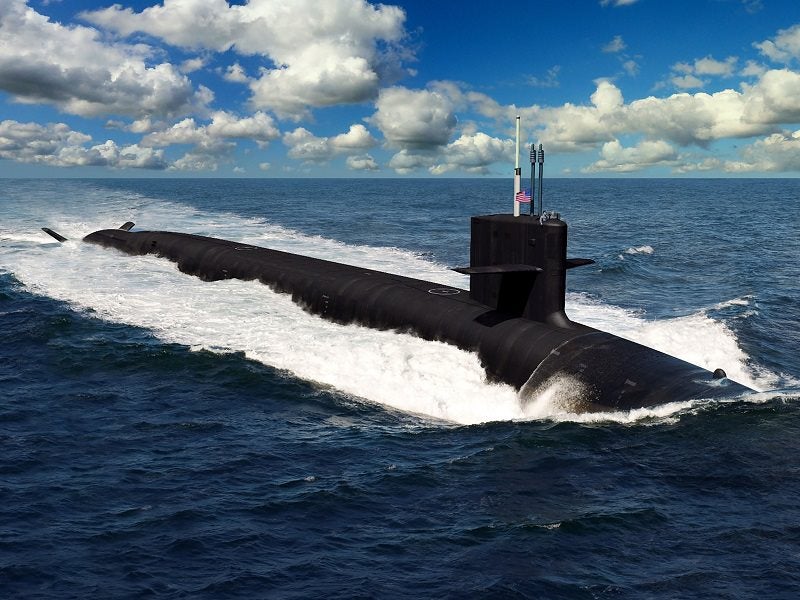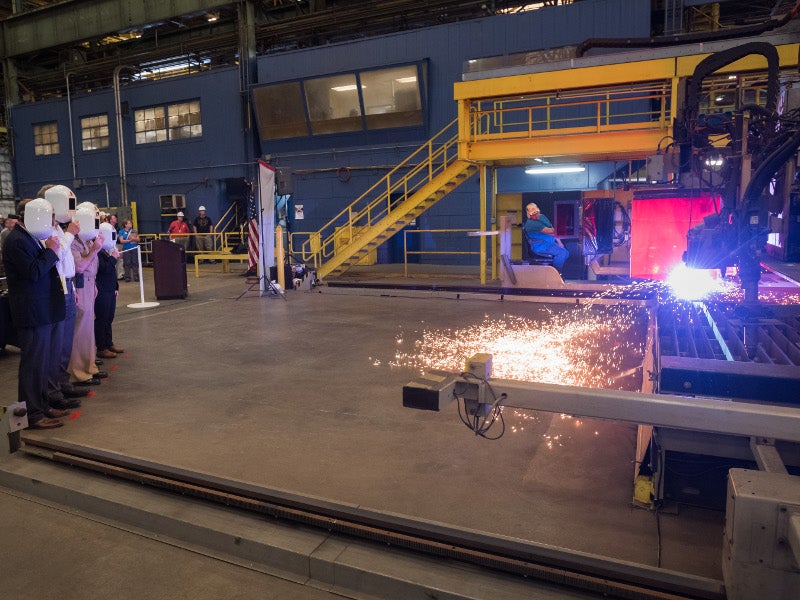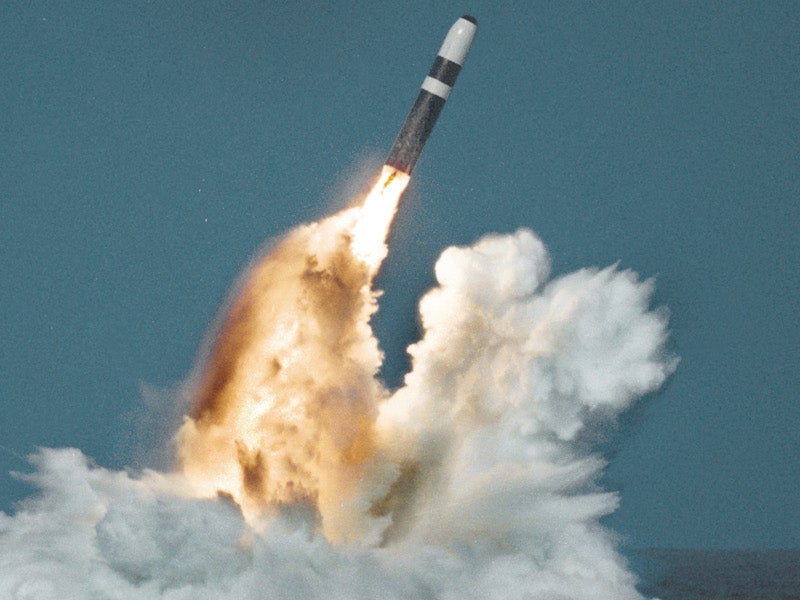Columbia-class ballistic missile submarines (SSBNs) are being constructed by General Dynamic subsidiary Electric Boat for the US Navy in collaboration with Newport News Shipbuilding.
Newport News Shipbuilding cut the first steel plate for the lead submarine in class, Columbia (SSBN 826), in May 2019. Construction of the submarine officially began in October 2020, while the keel-laying ceremony was held in June 2022.
The first boat is scheduled to be delivered in 2027. Following the delivery, the ship will undergo testing, with plans to get it ready for its first deterrent patrol in 2031.
The US Navy is planning to invest $132bn for the procurement of 12 Columbia-class submarines, which will replace its Ohio-class submarines.
The new submarines will support the US strategic deterrent mission, as the SSBN fleet of the US Navy carries 70% of the nation’s operational nuclear weapons.
The construction programme for the first two submarines is termed as Build I.
Electric Boat awarded a subcontract modification worth $567.6m to Newport News in April 2023 to provide long-lead-time material and advance construction works for Build II, which covers the next five ships in the class.
Columbia-class submarine programme details
The US Navy placed a $5bn detailed design contract with Electric Boat for the Columbia-class submarine programme in September 2017. Electric Boat awarded a $468m subcontract to Newport News Shipbuilding to support the construction of the submarines in December 2017.
Newport News Shipbuilding is responsible for engineering analysis, development of components, detail planning, and technical services.
Electric Boat acts as the prime contractor for the Columbia-class submarine programme, with 80% of the construction work being performed at Electric Boat’s facilities and the remaining 20% taking place at Newport News Shipbuilding’s facility.
The two shipbuilders will engage multiple vendors and suppliers to perform the work. Preliminary construction works began at Electric Boat’s facility in Quonset Point, Rhode Island, US, in 2017.
In May 2019, Electric Boat received a $497m contract modification to develop and expand the submarine industrial base in support of the Columbia-class and the Nuclear Shipbuilding enterprise.
The company secured a contract modification option worth $9.47bn from the US Navy for construction and continued testing of the first two ships in the class. The contract modification also includes associated design and engineering support.
The funds support the construction of the lead ship and procurement of components and advance construction works for the second submarine.
Newport News Shipbuilding received a contract modification worth $2.2bn from Electric Boat in November 2020 for the first two submarines.
The contract modification covers the construction and delivery of six module sections for each ship, in addition to efforts for continued design support. Newport News Shipbuilding will deliver the completed modules to Electric Boat, which will undertake the final assembly.
General Atomics Electromagnetic Systems delivered the first bearing support structure (BSS) for installation in the lead Columbia-class submarine in March 2022.
The company received a second order for the supply of the BSS in September 2021.
L3Harris received a contract from the US Navy to deliver submarine imaging masts and spares to provide enhanced capabilities to the Virginia- and Columbia-class submarines in July 2022.
The company will provide two configurations of its Type 20 low-profile mast, with initial deliveries expected to start in 2024.
Curtiss-Wright, a global engineered products provider, secured contracts worth $120m to supply generators for the Columbia-class submarine programme in September 2022.
Electric Boat was awarded a contract worth $5.1bn in December 2022 for advance procurement of long lead materials and construction of critical components to support the construction of Build II.
The contract is a modification of the previously awarded contract for integrated product and process development.
The funding also covers works to support the continuous production of missile tubes, improvements to the submarine industrial base development, and sustained maintenance and support.
Work under the contract modification is expected to be completed by October 2030.
Austal USA is responsible for constructing and outfitting electronic deck modules and command and control systems modules for integration into the Virginia- and Columbia-class ships.
BAE Systems Land & Armaments received a $71.9m contract to manufacture and deliver five components for the Columbia-class submarine programme in January 2023. The company is also supporting the US Navy in planning for the integration of the Trident II D5 missiles into the Columbia-class submarines.
Northrop Grumman is producing launcher subsystem hardware for the Columbia- and Dreadnought-class common missile compartment programme between the US and the UK.
The company’s Marine Systems business received a $458m contract in June 2022 to provide shipyard field operations, programme management, hardware production, systems engineering, documentation, and logistics for the Columbia and Dreadnought Fleet Ballistic Missile Program for the period between 2022 and 2026.
Leonardo DRS, a subsidiary of Italian company Leonardo, received contracts worth more than $1bn to supply integrated electric propulsion parts for the submarines in April 2023.
Design and features
The Columbia-class ballistic missile submarines will feature X-shaped stern control surfaces and sail-mounted dive planes. The hull will be covered with an anechoic coating.
The missile compartment will integrate four factory-made missile tubes equipped with a quad pack each. It will be built and assembled in parallel with the hull and integrated into the hull along with decks, other equipment and systems.
Each submarine will measure 170.7m long and will have a diameter of 13.1m. The submerged displacement of the boat will be 20,810 tonnes (t).
Weapon systems
Each submarine will be installed with 16 missile tubes for launching 16 Trident II D5 submarine-launched ballistic missiles.
Powered by three solid-fuel rocket motors, the three-stage missile can carry up to 14 multiple independently targetable re-entry vehicles with W88 or W76 thermonuclear warheads to a distance of 12,000km.
Sensors fitted to the Columbia-class ballistic missile submarines
The submarines will feature a large aperture bow (LAB) sonar system and can also be outfitted with a submarine warfare federated tactical system (SWFTS) for integrating sonar, optical imaging, and weapons control systems.
The horse-shoe-shaped LAB sonar is made of special composite materials to enhance the transfer of acoustic signals.
Propulsion and performance
The electric-drive propulsion system onboard the Columbia-class ballistic missile submarines will include an electric motor driving the propeller of the boat. It is expected to be quieter than a mechanical drive system.
Submarines will use a nuclear reactor to generate energy, which will be converted into electrical power to fuel the electric propulsion motor.
A midlife nuclear refuelling will not be necessary as the fuel core will power the Columbia-class submarine for its entire service life.
The propulsion system will enable the submarine to sail at a speed of more than 20 knots and operate at a depth of 800ft.
Each submarine in the Columbia-class is expected to carry out 124 deterrent patrols during its service life of 42 years.






